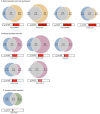This is a preprint.
Identification of Novel Loci and Cross-Disorder Pleiotropy Through Multi-Ancestry Genome-Wide Analysis of Alcohol Use Disorder in Over One Million Individuals
- PMID: 38196616
- PMCID: PMC10775504
- DOI: 10.21203/rs.3.rs-3755915/v1
Identification of Novel Loci and Cross-Disorder Pleiotropy Through Multi-Ancestry Genome-Wide Analysis of Alcohol Use Disorder in Over One Million Individuals
Update in
-
Identification of risk variants and cross-disorder pleiotropy through multi-ancestry genome-wide analysis of alcohol use disorder.Nat Ment Health. 2025 Feb;3(2):253-265. doi: 10.1038/s44220-024-00353-8. Epub 2025 Jan 8. Nat Ment Health. 2025. PMID: 40322774 Free PMC article.
Abstract
Alcohol use disorder (AUD) is highly heritable and burdensome worldwide. Genome-wide association studies (GWASs) can provide new evidence regarding the aetiology of AUD. We report a multi-ancestry GWASs across diverse ancestries focusing on a narrow AUD phenotype, using novel statistical tools in a total sample of 1,041,450 individuals [102,079 cases; European, 75,583; African, 20,689 (mostly African-American); Hispanic American, 3,449; East Asian, 2,254; South Asian, 104; descent]. Cross-ancestry functional analyses were performed with European and African samples. Thirty-seven genome-wide significant loci were identified, of which seven were novel for AUD and six for other alcohol phenotypes. Loci were mapped to genes enriched for brain regions relevant for AUD (striatum, hypothalamus, and prefrontal cortex) and potential drug targets (GABAergic, dopaminergic and serotonergic neurons). African-specific analysis yielded a unique pattern of immune-related gene sets. Polygenic overlap and positive genetic correlations showed extensive shared genetic architecture between AUD and both mental and general medical phenotypes, suggesting they are not only complications of alcohol use but also share genetic liability with AUD. Leveraging a cross-ancestry approach allowed identification of novel genetic loci for AUD and underscores the value of multi-ancestry genetic studies. These findings advance our understanding of AUD risk and clinically-relevant comorbidities.
Conflict of interest statement
Disclosures Dr. Dale is a founder of and holds equity in Cortechs.ai and serves on its scientific advisory board; he is a member of the scientific advisory boards of HealthLytix and the Mohn Medical Imaging and Visualization Center (Bergen, Norway); and he receives funding through a research agreement between General Electric Healthcare and UCSD. Prof. Andreassen has received speaking honoraria from Lundbeck and has served as a consultant for HealthLytix. Dr. Kranzler has served on scientific advisory boards for Dicerna and Sophrosyne Pharmaceuticals, as a consultant for Sobrera Pharmaceuti-cals, and as a member of the American Society of Clinical Psychophar-macology’s Alcohol Clinical Trials Initiative, which during the past 3 years was supported by AbbVie, Alkermes, Amygdala Neurosciences, Arbor Pharmaceuticals, Dicerna, Eli Lilly, Ethypharm, Indivior, Lundbeck, Otsuka, and Pfizer, and he is named as an inventor on PCT patent application 15/878,640, “Genotype-guided dosing of opioid agonists.” The other authors report no financial relationships with commercial interests.
Figures





References
-
- Milanzi EB, Ndasauka Y. Prevalence of Alcohol Addiction in Africa. In: Ndasauka Y, Kayange GM, editors. Addiction in South and East Africa : Interdisciplinary Approaches [Internet]. Cham: Springer International Publishing; 2019. [cited 2022 Sep 6]. p. 215–28. Available from: 10.1007/978-3-030-13593-5_13 - DOI
-
- Carvalho AF, Heilig M, Perez A, Probst C, Rehm J. Alcohol use disorders. The Lancet. 2019. Aug 31;394(10200):781–92. - PubMed
Publication types
Grants and funding
LinkOut - more resources
Full Text Sources

